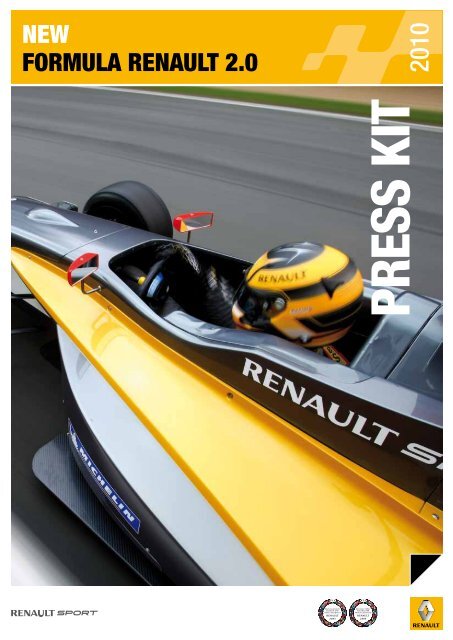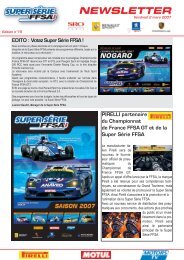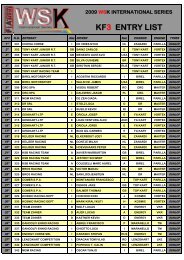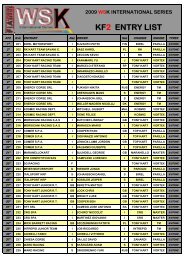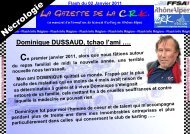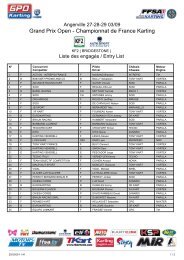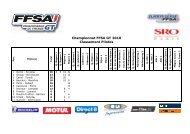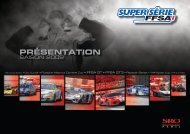NEW FORMULA RENAULT 2.0
NEW FORMULA RENAULT 2.0
NEW FORMULA RENAULT 2.0
You also want an ePaper? Increase the reach of your titles
YUMPU automatically turns print PDFs into web optimized ePapers that Google loves.
2New Formula Renault <strong>2.0</strong> :
a worthy successorDecidedly modern with flowing, sensual lines, New Formula Renault <strong>2.0</strong> has been designedto give young drivers aiming to graduate to Formula 1 the perfect tool to hone their talent.Successor to the best-selling single-seater in the world, this new generation race car has beendeveloped and manufactured by Renault Sport Technologies. The car will make its competitivedebut in 2010 in the Eurocup Formula Renault <strong>2.0</strong> and national championships.Formula Renault has been an essential stage inthe career of many young drivers for close to thirtyyears. Alain Prost, René Arnoux, Didier Pironi andmore recently, Kimi Räikkönen, Lewis Hamilton,Robert Kubica and Felipe Massa all made a name forthemselves in Formula Renault at the start of theircareers. The 2010 season will see the competitivedebut of New Formula Renault <strong>2.0</strong>, devised anddesigned by Renault Sport Technologies to giveyoung drivers the chance to learn about a race carwith features and handling similar to those used inthe more prestigious categories.The honeycomb and carbon-fibre monocoqueis the first to be awarded the FIA F3 2011homologation. Studied using wind tunnel testsand CFD (Computational Fluid Dynamics), the car’saerodynamic downforce is significantly greater thanthat of its predecessor, enabling it to corner at higherspeeds.The 210bhp 4-cylinder <strong>2.0</strong>-litre 16V engine, derivedfrom Clio III Renault Sport Phase 2, is combined witha seven-speed sequential gearbox with electricsteering wheel mounted paddles. New FormulaRenault <strong>2.0</strong> therefore comes with a transmissionsystem that was previously unavailable for race carsin this category or at this price. The new gearboxoffers drivers the opportunity to grapple with the kindof system they will encounter throughout their racingcareers, right up to the dizzy heights of F1.Fitted with adjustable twin-tube shock absorbers,the suspension system features two conventionalsolutions: single shock absorber at the front anddouble shock absorber at the rear. Michelin hascustom-developed wider tyres for the car. NewFormula Renault <strong>2.0</strong> is now able to complete 200kilometres on the same set of tyres.The new car’s braking system reveals another of itsstrengths. Identical on all four wheels, the floatingbrake disc system with four-piston calipers offersgreater performance and durability.A key ingredient in modern motorsport, particularattention has been paid to the car’s onboardelectronics. Engine and gearbox management ishandled by an ECU that may only be accessedby Renault Sport. A second unit manages dataacquisition, which makes full use of the car’s built-insensors. The new steering wheel, featuring a built-incolour dashboard display, provides drivers and teamswith a wealth of information.A development programme covering over 6,000kilometres, led by Renault Sport Technologies’technical teams and the drivers Filipe Albuquerque,Alvaro Parente and Andy Soucek, clearly demonstratedthe car’s improved performance levels.New Formula Renault <strong>2.0</strong> calls upon deft drivingskills, very similar to those needed to drive a FormulaRenault 3.5. Thanks to its optimized design, incrediblereliability and a reduced number of spare parts, NewFormula Renault <strong>2.0</strong>’s running costs have been cutby 10%. Assembled at the Alpine plant in Dieppe,the race cars undergo thorough inspection and roadtesting prior to delivery. New Formula Renault <strong>2.0</strong>is available in race-ready configuration at €57,500excl. tax. It is set to make its competitive debut in2010 in the Eurocup Formula Renault <strong>2.0</strong> and nationalchampionships.3
CONTENTSSECTION 1Formula Renault, a category rooted in the history of motorsport...........................5SECTION 2Styling & aerodynamics: a sensual, smooth race car ..................................................6SECTION 3Chassis systems and ground link technology: out-and-out performance..............8SECTION 4Engine and gearbox: mixing it with the big boys ............................................................10SECTION 5Onboard electronics: more modern and more precis...................................................12SECTION 6Even greater safety..................................................................................................................13TECHNICAL DATA SHEET.................................................................................................................144
SECTION 1Formula Renaulta category rooted in the history of motorsportSince its official launch in 1971, Formula Renaulthas become an essential stage in the career ofany talented young driver hoping to reach theupper echelons of motorsport. Alain Prost, LewisHamilton, Kimi Räikkönen and Felipe Massa, notto mention many other F1 drivers, have all graduatedfrom racing in Formula Renault.It all started back in 1968, when the French MotorsportFederation, the FFSA, launched Formule France,with a Gordini-powered single-seater race car.Three years later, the category was taken over byRenault, who renamed it Formula Renault. On Frenchtracks, the burgeoning talents of Jacques Laffite, PatrickTambay and many others were unveiled duringsome memorable early races.In 1975, the formula moved onto the internationalscene: Formula Renault Europe was created, withRené Arnoux winning the title ahead of Jean Ragnotti.The following year, Alain Prost became FrenchChampion, winning an incredible 12 races out of 13,whilst Didier Pironi claimed the European crown. Thecategory’s reputation was growing – it was alreadythe best way to access the world of F1.Normally-aspirated or turbocharged engine, unrestrictedor single-brand chassis: the formula has justgone from strength to strength as the years havegone by and the car has evolved. The name FormulaRenault has become familiar to all motorsport fans.In 2000, the formula made a major breakthrough withthe introduction of the current Formula Renault <strong>2.0</strong>.That year, a certain Kimi Raïkkönen won the FormulaRenault <strong>2.0</strong> UK championship and created a stir whenhe went straight into Formula 1!Between 2000 and 2009, Formula Renault <strong>2.0</strong> becamethe best-selling single-seater in the world,with 950 chassis produced and championships organizedthroughout the world. Designed to build onthis success, New Formula Renault <strong>2.0</strong> will make itsofficial competitive debut in 2010.Past winners of the Eurocup FR <strong>2.0</strong>2009 Albert Costa2008 Valtteri Bottas2007 Brendon Hartley2006 Filipe Albuquerque2005 Kamui Kobayashi2004 Scott Speed2002 Eric Salignon2001 Augusto Farfus2000 Felipe Massa1999 Gianmaria Bruni1998 Bruno Besson1997 Jeffrey van Hooydonk1996 Enrique Bernoldi5
SECTION 2Styling & aerodynamics:a sensual, smooth race carENew Formula Renault <strong>2.0</strong> is a totally new racecar. Whilst maintaining a strong Renault Sportidentity, especially thanks to the F1-inspiredfront splitter, the car’s sensual, flowing lineslend it a distinctive look.A strong identityDevised by Renault Design in conjunction with RenaultSport Technologies, New Formula Renault <strong>2.0</strong>’smost striking feature is its sensual, flowing exteriordesign. Instantly recognizable, the car’s strong identityspeaks volumes about its pedigree, with a perfectbalance between style and aerodynamic efficiency.The F1-inspired front splitter, also featured on FormulaRenault 3.5 and Mégane Trophy, makes it clearthat this is a Renault Sport.The design integrates the constraints required by the2011 FIA F3 safety standards. New Formula Renault<strong>2.0</strong> is the first single-seater to meet the necessarycriteria, including a new rear crash box and a neckrestraint combined with the removable bucket seat.6
More aerodynamic downforce meansbetter cornering performanceNew Formula Renault <strong>2.0</strong> makes use of the latestadvances in technology to achieve outstandingaerodynamic performance. As is the case on allmodern race cars, downforce is generated bythe adjustable front and rear wings and by thecombination of undertray and diffuser, which pin thecar to the track by accelerating the airflow beneaththe car.The aerodynamic options selected for New FormulaRenault <strong>2.0</strong> were confirmed following extended windtunnel testing, initially on a model 30% of full sizeand then on a full-scale prototype. Aerodynamicefficiency was equally optimized using CFD, acutting-edge technology used by Renault F1 Teamand by Renault Sport Technologies on MéganeTrophy. CFD (Computational Fluid Dynamics) involvesstudying the movements of a fluid, or their effects,by using computers to solve the equations governingthe fluid.New Formula Renault <strong>2.0</strong> aerodynamic characteristicsalso promote better cornering performance. Asthe car is more sensitive to setup adjustment thanits predecessor, the drivers will need to describeits handling very precisely and work in very closeconjunction with their engineer in order to definethe optimum setup for each track, a habit which willserve them well for the rest of their racing careers.7
SECTION 3Chassis systems and ground link technology:out-and-out performanceThe honeycomb and carbon-fibre monocoque benefits from Renault Sport Technologies’ extensiveknow-how in chassis design. Bringing together perfect mass distribution and compliance with thestrictest safety standards, New Formula Renault <strong>2.0</strong>’s chassis has been designed to combine efficiencyand quality.A structural designintended to keep costs downNew Formula Renault <strong>2.0</strong> has been designed basedon a carbon-fibre monocoque that complies with the2001 FIA F3 standards, with self-supporting engineand gearbox. All of the bodywork parts are equallymade of carbon fibre. The car is therefore able toboast an ideal weight distribution, with 43% at thefront. The kerb weight of the race car is just 505kg.Always determined to cut running costs, RenaultSport Technologies and its technical partners havedesigned a race car that makes it easier for mechanicsto carry out work rapidly. For example, the undertrayis divided into three parts. In the even of an accident,it is therefore possible to change just the damagedpart. This approach to the design also makes it easierto access the various mechanical components..Handles like a ‘‘mini F1’’A race car must offer perfect roadholding, the aimbeing to constantly improve cornering speed. Toimprove its handling, New Formula Renault <strong>2.0</strong>has been fitted with the latest in adjustable twintubeshock absorbers at the rear, whilst the frontsuspension uses a single shock absorber.Several possibilities are available for independentadjustments to the setup: ride height, wheel alignment,anti-roll bar, roll centre height and anti-squat.Capable of cornering at higher speeds and requiring8
more precision and subtlety from drivers, NewFormula Renault <strong>2.0</strong> delivers significantly betterperformance than its predecessor.The on-track handling is very close to that of its‘‘big sister’’, Formula Renault 3.5. The driving styleneeded for the two Renault Sport cars is very similar.In an effort to put together a driver developmentprogramme guiding the most promising drivers allthe way to Formula 1, there will be a natural andeasy progression from New Formula Renault <strong>2.0</strong> toFormula Renault 3.5.<strong>NEW</strong> TYRES FROM MICHELINTo exploit its full potential, Michelin has customdevelopedtyres for New Formula Renault <strong>2.0</strong>. Thetyres are wider than on the previous version – 20/54-13 at the front and 24/57- 13 at the rear – furtherimproving the car’s balance. The lifespan of thetyres has also been significantly lengthened, whichcan now cover up to 200 kilometres on the track.Consequently, fewer set of tyres are required for aseason.More powerful braking systemBraking is a strong point on all Renault Sport cars.Consistent with the cost-cutting approach pursuedelsewhere on the car, the design office engineersselected the same components for the front andrear brakes, using discs with 4-piston calipers.The effectiveness of the braking system has beenincreased by using floating discs, which producea reduction in friction and unsprung mass. It istherefore possible to brake harder and later than onthe previous generation of race car.9
SECTION 4Engine and gearbox: mixing it with the big boySNew Formula Renault <strong>2.0</strong> is fitted with a brand new engine and gearbox. The 210bhp <strong>2.0</strong>-litre 16V engine iscombined with a seven-speed sequential gearbox with electric steering wheel mounted paddles. A first fora Renault Sport-branded race car.A new 210bhp <strong>2.0</strong>-litre 16V engineNew Formula Renault <strong>2.0</strong> takes its four-cylinder,<strong>2.0</strong>-litre normally-aspirated engine from Clio III RenaultSport Phase 2. Although this engine develops twentymore horsepower than on the current FR<strong>2.0</strong>, it remainsclose to the production version. Specific preparation forthe racing version involved the addition of a dry sump,a new oil pump and reinforced connecting rod bolts. Itwas possible to keep the production intake manifoldand motorized throttle valve, however, when the enginewas integrated in the car.Aside from the engine’s performance, reliabilitywas given special attention during the research anddevelopment conducted by Renault Sport Technologies.Over 5,500 kilometres of testing were successfullycompleted – equivalent to the theoretical lifespan of enengine – without the slightest problem.F1-style transmissionThe most significant innovation lies in thetransmission: New Formula Renault <strong>2.0</strong> is fitted witha seven-speed, sequential gearbox with steeringwheelmounted paddles. Drivers taking their firststeps in motor racing will therefore get used to asystem that is similar to that used at the highest levelof the sport, in Formula 1.Electric controls, via an actuator, not only enablequicker gear changes but are also much simpler touse and facilitate quicker maintenance operations.The seven-speed gearbox only requires one gearratio setting for the entire season, which reducescosts even further. For tracks with a very highmaximum speed, such as Monza, a longer seventhgear is available.10
SECTION 5Onboard electronics: more modern and more preciseParticular attention has been paid to New Formula Renault <strong>2.0</strong>’s onboard electronics, with a new ECU,built-in sensors and new data acquisition software.Two electronic units at the core ofNew Formula Renault <strong>2.0</strong>Renault Sport Technologies has totally redesigned New FormulaRenault <strong>2.0</strong>’s onboard electronic management system so as toimprove the car’s performance and make it easier to operateas well as ensuring that competitors are treating perfectlyequally from a technical point of view.The race car is now equipped with two ECUs. The first, whichmay only be accessed by Renault Sport Technologies’ engineers,manages engine and gearbox operations. Inspections are thusmade easier, ensuring the sporting equity of events.The second ECU is devoted to data acquisition. Combinedwith the Pi Toolbox suite, the gold standard of data analysissoftware used in motor racing, this ECU can be used to accessall of the car’s data. More modern and easy-to-use, this newdata acquisition system makes life even easier for drivers andengineers alike.New Formula Renault <strong>2.0</strong> also comes with built-in chassissensors, enabling the teams to access even more parameters.The latest in steering wheel technologyThe new steering wheel, equipped with a colour dashboarddisplay, gives drivers and teams access to a wealth ofinformation. Several screens are devoted to technicaldiagnostics. It is therefore possible to identify the sourceof a problem immediately without needing to use the dataacquisition software.The driver is able to switch between two screens whilst driving,each offering a variety of information. It is also possible todownload and view the track map. The driver can – in realtime – compare his/her lap times with a reference time, whichcan either be his/her best lap time, or the best time of anotherdriver.12
SECTION 6Even greater safetyDriver safety remains Renault Sport Technologies’ no.1 priority. New Formula Renault <strong>2.0</strong> is the firstsingle-seater race car to have been designed in accordance with the 2011 FIA F3 standards. With a finishthat is equally remarkable, this race car looks certain to set new standards in its category.Optimum safetySafety is a key strategic goal for Renault Sport in thedevelopment of its cars, and special care has beentaken to afford New Formula Renault <strong>2.0</strong> drivers the bestpossible protection in the event of an accident.New Formula Renault underwent a series of demandingtests to ensure it complied with the latest safetystandards set out by the FIA:• Static load test then crash test on the front and rearcrash boxes• Crash tests on the steering column• Crash box pull-off resistance tests• Static load test on the safety roll cage• Pull-off resistance test on the safety roll cageNew Formula Renault <strong>2.0</strong> also comes with wheelretentioncables, a removable seat and a neck restraintto protect the driver’s head.A remarkable finishEverything has been designed to make life easier fordrivers and teams. From the comfort of the bucket seatdesigned to accommodate the HANS system, the driverhas all the key data to hand on the display built into thesteering wheel. The pedals can be removed easily, whichmeans they can be adjusted from the outside.A series of carefully thought-out details help to reducethe time needed to carry out work on the car. For example,it is possible to change the clutch without removing theclutch case. It is also possible to change the enginewithout having to interchange the powertrain/oil tank.New Formula Renault <strong>2.0</strong> will be assembled at the Alpineplant, in Dieppe. It will be road-tested and tuned prior tobeing delivered in race-ready configuration.13
TECHNICAL DATA SHEETChassisEngineType Honeycomb and carbon fibre monocoqueBodywork Carbon-fibreAerodynamic features Front and rear wings, diffuserLayout Self-supporting engine and gearboxType Renault F4R 832 – 4 cylinder – 16 valve – 1,998cc – 1998 cmBore x stroke 82.7 x 93mmFuel injection/ignition Built-in management systemTransmissionMaximum power 210bhp at 7,150rpmMaximum torque 220Nm at 5,500rpmMax. engine speed 7,500rpmType Rear-wheel driveGearbox Sequential, 7-speed + reverseGearshift Electric semi-automatic steering wheel mountedDifferentialLimited slip, auto-locking differential with clutch discs andramp pressure platesClutch Cerametallic twin-diskAxles and suspension systemsWheelsSuspensionFront: single adjustable twin-tube shock absorberRear: double adjustable twin-tube shock absorberBrakes 278 x 18mm floating discs and 4-piston callipersWheel rims One-piece aluminium wheel rims, 9 x 13 (front) and 10.5 x 13 (rear)Dimensions, weight and capacitiesPriceTyres Michelin tyres, 20-54 x 13 (front) and 24-57 x 13 (rear)Length 4,391 mmFront and rear track 1502 – 1440 mmFuel tank 50 litresKerb weigh 505 kgFull car €57,500 excl. tax (price subject to entry in a Renault Sport championship)14
[ media.renault-sport.com ]Edition and conception : Zone Rouge - Photos : Greg, DPPI


